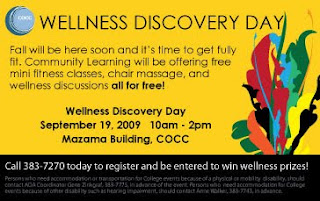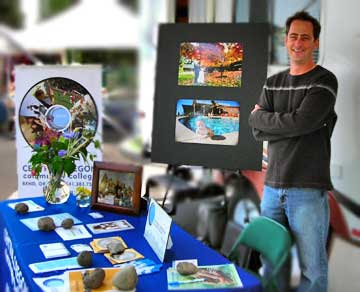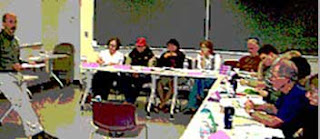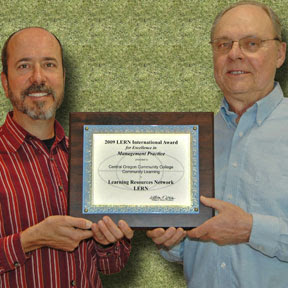
Monday, December 14, 2009
Monday, December 7, 2009
Getting Ready for the Winter Session
 In order to be ready for a new session and its classes, I review a check list of activities that help set the tone for the classes. The list is shown below. Give it a try.
In order to be ready for a new session and its classes, I review a check list of activities that help set the tone for the classes. The list is shown below. Give it a try. - Contact the students before the class begins and offer suggestions on materials they will need to bring, location of the classroom, parking issues, etc.
- Greet the student at the classroom door and introduce yourself.
- Provide materials for making table tents or name tags to help others know their classmates.
- Inform the students about break times, restroom locations, cell phone etiquette, etc.
- Conduct an ice breaker to help people feel comfortable.
- Start the class on time.
- Give an overview of the class.
- Provide frequent breaks during the meeting.
- Encourage participation.
- Conclude the class on time
Monday, November 30, 2009
Heading off Problems in Class
Frequently problems or inappropriate behavior in class can be avoided by being proactive. Try some or all of the suggestions or add your own.
- Lower your voice. Lowering the voice gives the students the illusion that you calm and in control.
- Recognize the source. The student might be uncomfortable with her/his competency.
- Slow down. Slow down your delivery and offer students enough think-time after questions have been asked.
- Give yourself think time. Don’t say the first thing that comes to mind when a student makes an inappropriate comment.
- Watch for the warning signs. If a student is becoming agitated, intervene with a quiet word or change the pace of classroom activities.
- Talk one-to-one. If possible, talk to the disruptive student alone and not in front of the entire class.
- Acknowledge the student’s concern. If you cannot address the students’ problem when it occurs, openly acknowledge that you are aware of the issue and will return to it.
- Build a relationship with your students. Find out what they enjoy and show an interest in it.
Monday, November 23, 2009
Monday, November 16, 2009
It Is Out There
 Have your students asked if there is a “next” level class? Do you have any ideas for a class that would interest the students? Have you identified a need that could result in an interesting class?
Have your students asked if there is a “next” level class? Do you have any ideas for a class that would interest the students? Have you identified a need that could result in an interesting class?If so, please contact your program manager and discuss what you have found. Everyone in the department is always interested in new classes.
Monday, November 9, 2009
Help with Learning the Vocabulary
 Here is a fun way to help students remember key words related to classroom activities. It is called Wordle and is free with no login or passwords to remember.
Here is a fun way to help students remember key words related to classroom activities. It is called Wordle and is free with no login or passwords to remember.I created the Wordle to the right using key words from the Photoshop Elements class. I found that it required me to think rather seriously about the most important terms used in class.
Begin the fun by having the students go to http://www.wordle.net/create.
- Next, have them enter the important words from the class into the “Paste in a bunch of words” box. The size of a word in the final product is determined by the number of times it is entered.
- Two or more words can be kept together with a space between them by using the tilde (~).
- When finished click on GO.
- The next Wordle screen offers choices for changing the language, font, layout and color. Experimenting with them produces some nice variations. More variations can be seen by clicking the Randomize button at the bottom of the screen.
- Use the Print button to print a copy of the Wordle.
- The Save to public gallery… button places the Wordle on the Internet. Once there, it cannot be changed or removed.
- The Wordle cannot be saved to disk. However, a digital copy can made using a screen capture technique/software.
- If you navigate away from the Wordle you have created, all will be lost, i.e. you will need to start over.
Monday, November 2, 2009
A Word About Our Current Processes Here at Community Learning
 Just thought now would be a good time to fill you in on what is going on in the office.
Just thought now would be a good time to fill you in on what is going on in the office.Do you feel like we have been on your case to get information back to us? We have been with some of you. We are just putting the Winter schedule to bed which means we have needed you to return your contracts, get bios and material lists to us, etc.
We are done with our planning, finding space for your class (this is getting harder each term), etc. for the moment. Now we are putting on the finishing touches and checking the last details to make sure everything is good to go with the printed and web schedule.
Our turn-around time for winter term is about 7 weeks. For Spring/Summer term it is about 5 weeks and for Fall it is about 10 weeks. We love Fall planning. This means things will get more hectic for us and you in less than a month.
So we want you all to know a few things: that we will be bugging you again soon. We always welcome your new class ideas. And we always appreciate the great job you do in the classroom. Please know also that we are doing our job to make yours easier and more fun.
Thanks,
Paul Stennett
Monday, October 26, 2009
Climate Change in the Classroom
 Asking a question of the class and receiving an incorrect answer can create a challenging situation. How the instructor responds often sets the climate for future question and answer sessions.
Asking a question of the class and receiving an incorrect answer can create a challenging situation. How the instructor responds often sets the climate for future question and answer sessions.To help maintain a nurturing climate, Richard Paul, in his book titled Critical Thinking, suggested the instructor respond to an incorrect answer by using one or more of the following.
What do you mean by _____?
Can you give me an example of _____?
How does that relate to the question?
All of your answer depends on the idea that _____.
Why did you base your answer on this rather than _____?
What are your reasons for saying this?
Let me see if I understood you. Do you mean _____?
Could you explain your answer further?
Can you rephrase your answer?
What I heard you say was _____. Is that what you meant?
Let me rephrase the question. Now, what do you think?
*Paul, Richard. 1995. Critical Thinking: How to Prepare Students for a Rapidly Changing World. Dillion Beach: Foundation for Critical Thinking.
Monday, October 19, 2009
Myth Busting: Is Multitasking a Good Thing?
 Have you ever wondered if multitasking saves time or is a good way to learn or if you are too old to remember all the tasks?
Have you ever wondered if multitasking saves time or is a good way to learn or if you are too old to remember all the tasks?Well, a recent issue of Inside the School carried an article by Maryellen Weimer that indicated we may need to rethink our multitasking, at least when it comes to education. Titled “Three Multitasking Myths,” it discusses research related to each of the following urban myths:
- Multitasking saves time.
- Multitasking is as good as single-task learning.
- Multitasking is for the young.
The end result: all three of the myths were busted.
Read the complete article by clicking here.
Monday, October 12, 2009
Playing a Video/Movie From Within PowerPoint 2007
I recently attended a two-hour public meeting where the speakers gave PowerPoint presentations. There were videos shown during the slide shows, usually less than a minute in length that depicted a humorous aspect of the topic being discussed. Being short and funny, the videos made a nice comic-relief.
To run a video, the speaker minimized PowerPoint and used another program to play it. Not only was the practice cumbersome, it was unnecessary. In other words, it is possible to run a video from within PowerPoint.
Use the following procedure to insert a movie into PowerPoint 2007.
- Open the program.
- Display the slides of the presentation.
- Select the slide to receive the movie or create and select a new slide for the movie.
- Click on the Insert tab.
- Click on Movie in the Media Clips pane (far right on the Ribbon).
- Click on Movie from File.
- Click on the movie to insert.
- Click OK.
- In the dialog box, click on When Clicked.
To save the slide show with its movie (note: the movie MUST be saved in the same location as the slide show):
- Click on the Office Button.
- Click on Save As.
- Choose either a:
- PowerPoint Presentation (opens in the PowerPoint program) or
- PowerPoint Show (opens in Slide Show view) or
- PowerPoint 97-2003 Presentation (some PowerPoint 2007 functions may be lost).
To view the movie within the slide show:
- Run the slide show.
- At the slide with the movie, click the movie area.
- Click outside the movie area to stop the movie or to continue the slide show.
Monday, October 5, 2009
Five More Teaching Tips
 The following five teaching tips build upon the ten teaching tips posts of May 21 and May 28, 2008.
The following five teaching tips build upon the ten teaching tips posts of May 21 and May 28, 2008.1. Build relationships with the students. Talk to them about their hobbies, interests, activities, etc.
2. Relate their hobbies/interests/activities to class content. As a result, they can connect more easily with the subject matter.
3. Ask questions regarding a student’s response. Attempt to determine what the student had in mind when responding to classroom material.
4. Be fair. Being fair in this context means everyone receives what they need.
5. Be organized. Not only does it make the class progress smoothly, it usually helps the students learn the material.
Monday, September 28, 2009
Make the Courtesy Call
 Has someone given you a courtesy call to remind you of an appointment? I find them to be of value and decided to extend the same courtesy to my students. It has turned out to make the beginning of class much smoother. This results from the calls being a time to answer questions and/or pass on additional information.
Has someone given you a courtesy call to remind you of an appointment? I find them to be of value and decided to extend the same courtesy to my students. It has turned out to make the beginning of class much smoother. This results from the calls being a time to answer questions and/or pass on additional information.An example that comes to mind is the student who informed me during the call that they would not be unable to attend the class. I advised them to contact the department at (541) 383-7270 and make the necessary arrangements. Additional information that can be given includes:
- A statement about parking conditions.
- What items the student needs to bring to class.
- The availability of food.
- Directions to the classroom.
I make the call about a week in advance of the class. The script is along the following lines:
Hi, my name is (your name) and I am calling to remind you that our class (fill in the topic) will be starting on (fill in the day), at (fill in the time). It is located in room (fill in the number), at the (fill in the campus).
Contact your program manager for a class roster with names and telephone numbers.
Monday, September 21, 2009
Dept. Instructor Featured in College Publication
 Annette Witzel, longtime instructor in the Community Learning Department, was the subject of an article in the campus publication titled, Connecting With Our Community. The publication was mailed to thousands of home owners throughout Central Oregon.
Annette Witzel, longtime instructor in the Community Learning Department, was the subject of an article in the campus publication titled, Connecting With Our Community. The publication was mailed to thousands of home owners throughout Central Oregon.The article recaps Annette’s distinguished career as a teacher of computer applications. The interviewer asked the following questions:
- What is the key to successfully teaching computer classes?
- What are your most popular classes?
- What are your favorite classes to teach?
- How would you describe your teaching style?
- What is the best aspect of teaching for you?
Of course, Annette answered the questions in her usual charming manner. Thus, she provides us with a great opportunity to discover how an outstanding instructor views her teaching while sharing her classroom strategies.
Read the entire article by clicking here.
Monday, September 14, 2009
What did you do this summer?
Susan: My summer was filled with enjoying my garden and lots of day kayak trips to our beautiful lakes nearby. Also walked the river trail 4 -5 times a week.
Rachel: Summer is traditionally a time to leave your hometown and get away. But I live in Central Oregon and I love Central Oregon in the summer. It’s like being on vacation already! Consequently, my family and I rarely leave home in the summer and this year was no exception. I spent my summer kayaking, hiking, riding my bike and taking fitness classes. I tried some new activities I hadn’t done before and met some wonderful people. My husband and I climbed South Sister for the first time. I did a lot of yoga with many of the talented and varied yoga teachers in town. In between activities, I spent time with our 15-year old behind the wheel learning how to drive a stick shift. We were the little red truck stalled at the entrance to one of the hundreds of roundabouts in Bend. Our apologies if you were stuck behind us!
I always feel a little sad to see the slower pace of summer days coming to a close but in the evenings when I walk our dog and feel the temperature drop and smell the first hints of fall in the air, my sadness turns to anticipation for the colors of fall and the promise of snow. It occurs to me, though, that driving with a new driver in the winter isn’t going to be easy. Watch out for a little red truck sliding slowly into a roundabout near you.
Paul: I took a trip to see my daughter’s work in her Chemistry internship at the University of Utah. I also helped out covering for some vacation time for the chaplains at the hospital and lastly just hung out with my son. It went by fast and I enjoyed it.
Natalie: My summer was spent with my family doing the little things that make us happy, like star gazing, baking cookies, and running through the sprinkler. We also mulched – oh happy days!
Katharine: I worked over the summer and burned off the stress with a circumnavigation of Broken Top.
 Julie: I hung out with my hunk of a husband and perfect son. We ate, played and the days went by too quickly. Our 18 month old son now speaks two languages…we have a genius in our midst. It was great fun!
Julie: I hung out with my hunk of a husband and perfect son. We ate, played and the days went by too quickly. Our 18 month old son now speaks two languages…we have a genius in our midst. It was great fun!
Glenda: What summer?
Cristi: This summer I spent a week at the Oregon Coast with my dog Cooper, my daughter Stephanie and her friends (my husband also came for a couple of days). My other daughter, Jessica, came for a visit the next week from New York City. We spent that week kayaking, hiking, shopping and eating!
Carolyn: Hiked the Butte several times a week, got several kayaking trips in, camped on the coast and Redwoods and laughed with my friends.
Beth: I travel to Italy where I modeled for the Italian version of Vogue! Guess what? I made the front cover! My kids were selected to go to Princeton and Stanford even though they are still in middle school. And my husband was asked to serve as Ambassador to New Zealand but he had to turn it down to clean out the garage. We sold five houses in Central Oregon (what recessions?!?!) and all our stocks and investments grew by 50%. All in all I would say it was a pretty good summer.
Tuesday, September 8, 2009
START THE NEW SCHOOL YEAR WITH WELLNESS!
 Experience the Community Learning Wellness Discovery Day.
Experience the Community Learning Wellness Discovery Day. This is your chance to try something new for FREE.
The department wellness sampler is your day to try yoga, tai chi, qigong, Zumba, Hoop Dancing or International Dancing for the first time. Each sample is 20 minutes in length. There will also be a free chair massage given by the COCC Massage Program students.
Discover classes to fit your interests no matter where you are in life. We'll also have information on our fall Yoga Teacher Training, Nutritional Therapy and upcoming Certified Personal Trainer classes.
Monday, June 15, 2009
Community Learning Wellness Discovery Day

We’d love to have a large number of instructors available to talk about their classes. No one can excite people about YOUR class like YOU can! We will also be asking all our instructors to spread the word about this event as we get closer.
Building community and promoting lifelong learning are two of the best ways to promote wellness we know of—come help us spread the word. Please put this date on your calendar and plan to attend either as an instructor or just for fun as a participant.
Thanks to Rachel for the information on Wellness Day.
Please note that this is our last post until September. We hope to see you back here in the fall.
Have a great summer!
Monday, June 8, 2009
Larkspur Neighborhood Festival 2009
Visitors were attracted to the booth by colorful flower arrangements offered by Backyard Bouquets instructor Martha Church, information/demonstrations of Qigong by instructor Michelle Wood, and large portrait photographs from Chris Mather who will offer a portrait photography class in the fall (shown below).

Managers who manned the booth included Rachel Knox, Glenda Lantis, and Paul Stennett, who was represented by Tom McDannold. Everyone was involved with providing information about on-going classes, new offerings in the fall, along with seeking community input about courses to offer, etc.
A special thanks goes to Larry Nonemaker of Larry’s RV. Larry, who will teach a class in the Fall on RV maintenance, provided a new 26 foot trailer for our use. It made a great “booth.”
Monday, June 1, 2009
Want to Try Twitter?
 Everyone seems to be talking about Twitter. We have even made reference to it in this blog back on January 20, 2009. You may recall that it is often referred to as micro-blogging. The "micro" part is derived from being limited to 140 characters.
Everyone seems to be talking about Twitter. We have even made reference to it in this blog back on January 20, 2009. You may recall that it is often referred to as micro-blogging. The "micro" part is derived from being limited to 140 characters.If you have decided to give it a try, whether for classroom or business use, you will want to read an article titled, "The Four Stages of a Typical Twitter User."
According to the article’s author, Jason Hiner, once you make it to the fourth stage, you will be a convert. Read all of what he has to say by clicking here.
Monday, May 18, 2009
Use of Classroom Multi-media Equipment Becomes Easier
The equipment is known as the Centron TouchPanel Media Manager Control System. Fortunately, the name has been shortened to A/V Touch Control System. It allows one to select the desired device and control it by simply pressing an icon on a glass-covered screen.
The following Community Learning Teacher Video (CLTV) shows how easily the equipment can be used, thereby ending the time-consuming search for the hand-held device, correct button, on-off switch, etc. Begin the CLTV by clicking on the Play icon.
Monday, May 11, 2009
Mysteries of the Whiteboard
In response to last week’s post, we received several questions:
- What happened to the blackboard?
- Where is the chalk?
- What is the white thing in the front of the room and why does it have faint markings on it?
Take heart, it is merely the March of Progress. The blackboard has been replaced by the whiteboard because of a need to reduce dust in multimedia classrooms with their computers, data projector, DVD player, etc. The chalk has been replaced by erasable marker pen, the instrument used to write on the whiteboard. The shadows on the whiteboard are from those who previously used a marker on the whiteboard.
The Community Learning Teacher Video (CLTV) shown below offers suggestions on using the whiteboard more efficiently.
Monday, May 4, 2009
Remember When?
 Remember when you taught your first class for Community Learning? I recall lots of preparation, butterflies in the stomach, and a hope that the students showed up.
Remember when you taught your first class for Community Learning? I recall lots of preparation, butterflies in the stomach, and a hope that the students showed up.Let us revisit those exciting times in more detail while focusing on the classroom environment:
Please let us know your recollections for we are starting a new blog feature called the Community Learning Teacher Videos (CLTV). It will consist of short video clips that deal with a single item, like how to operate the audio-visual equipment, keep a room cool, clean a whiteboard, etc.
Place your recollections and suggestions on the blog by clicking on COMMENTS or share them with your program coordinator (Glenda, Nancy, Paul, Rachael). We will begin video-taping the CLTV clips as soon as we hear from you.
Monday, April 27, 2009
What classes should I take next?
 Students often ask, “What classes should I take next?” If the class they are completing was one of a sequence, I would suggest taking the next one in the sequence, even though I did not offer the class. However, I became stuck when asked what to take when there was no sequence. Feeling a need to help the students, I searched for a solution.
Students often ask, “What classes should I take next?” If the class they are completing was one of a sequence, I would suggest taking the next one in the sequence, even though I did not offer the class. However, I became stuck when asked what to take when there was no sequence. Feeling a need to help the students, I searched for a solution.The first place I looked was the current class schedule. Not surprising, there were a number of classes that expanded on various topics within my class. So, I wrote down the titles along with a brief description and created a handout. The handout was disseminated at the next meeting or emailed to the students if the class had concluded.
One such handout can be viewed by clicking here. Your program coordinator (Glenda, Nancy, Paul, or Rachael) can help you construct something similar.
Monday, April 20, 2009
A Teaching Resource:
The Teaching Professor
 A blog by the name of The Teaching Professor is a rich source of information on teaching students who attend colleges and universities. Much of what is posted on the blog is easily applied to the students enrolled in our community learning courses.
A blog by the name of The Teaching Professor is a rich source of information on teaching students who attend colleges and universities. Much of what is posted on the blog is easily applied to the students enrolled in our community learning courses.
Recent posts of particular note include:
“Factors That Lead to Rapport” (April 9, 2009), “Concerns About Active Learning” (April 3, 2009), and “Course Characteristics That are Most Important to Students” (March 31, 2009)
The Teaching Professor can be viewed at http://www.teachingprofessor.blogspot.com/
Monday, April 13, 2009
Applying the Three Principles of Memory
1. Memories are formed as the residue of thought. Help the students think about the material by clearly drawing their attention to what is important.
My approach has been to provide the students with a printed outline that focuses only on the most important elements of the meeting. Minor points, anecdotes, examples, etc. are not on the outline.
2. Memories are inaccessible, mostly due to missing or ambiguous cues. Provide cues (mnemonics, images, associations, etc.) and use them in class to help students connect with the important elements.
I offer a number of cues that have helped me develop memories related to the material. For example, a typical workflow process used in editing digital photos is to Rotate, Crop, Overall fixes, Individual fixes, Sharpen, Save. The mnemonics for the process is Real Crazy Or Insane Some Say.
3. People tend to think their learning is more complete than it really is. Students can confuse familiar with the material for actually knowing it (italics added). Encourage the over- studying of important parts.
It has often been said that the best way to learn something (over-study) was to teach it. Thus, I suggest that the students go home and teach the meeting’s topics to someone. When they can teach it without the “errrs,” “umms”, pauses, etc., they have over-studied!
Share some strategies you use with us.
Monday, April 6, 2009
Helping our Students Remember Class Material
 Puzzled why students cannot remember the steps necessary to complete a task?
Puzzled why students cannot remember the steps necessary to complete a task?Insight can be found in an article by Daniel T. Willingham where he discusses the issue from a cognitive psychology point of view. The article is full of ideas, examples, and suggestions on how we, as community learning instructors, can help our students.
The author’s position is that to remember something, one must have a memory of it. Further, he suggests there are three principles of memory. Helping the student develop those memories is the thrust of the following.
1. Memories are formed as the residue of thought. Help the students think about the class by clearly drawing their attention to what is important.
2. Memories are inaccessible, mostly due to missing or ambiguous cues. Provide cues (mnemonics, images, associations, etc.) and use them in class to help students connect with the important elements.
3. People tend to think their learning is more complete than it really is. Students can confuse familiar with the material for actually knowing it (italics added). Encourage the over- studying of important parts.
Monday, March 30, 2009
Sharing the Sidebar
 Annoyed by the whispered conversations that occur between two students during the lecture/discussion/Q&A?
Annoyed by the whispered conversations that occur between two students during the lecture/discussion/Q&A?For me, the annoyance derives not from being the center of attention, but rather that the conversation causes the chatting people to miss part of the class activity while interfering with their neighbors’ participation. No matter how I would intervene in the distracting behavior, I would feel awkward, sometimes like I had a major ego problem, sometimes creating a me-against-them situation, etc.
A nifty solution to this vexing problem was demonstrated when I recently attended a conference held on campus. The key note speaker was explaining how sharing information helped make the class a more rewarding experience. He pointed out that whispered conversations, which he called a "sidebar,” between two individuals were also a rich source of information that should be shared with the class. Being a valuable source, the "sidebar" group would be required to share their conversation with the class.
The first time two individuals put their heads together in a “sidebar,” the speaker stopped his discussion and ask the whisperers to share their “sidebar.” It was the last time anyone in the room had a whispered conversation!
Monday, March 23, 2009
More Fun with PowerPoint
 Last week’s post titled, “Three PowerPoint 2007 Tips,” generated lots of discussion and apparently changed some PowerPoint use. This week’s post has a bit of fun with the widely-used presentation program.
Last week’s post titled, “Three PowerPoint 2007 Tips,” generated lots of discussion and apparently changed some PowerPoint use. This week’s post has a bit of fun with the widely-used presentation program.The fun is brought to us by Don McMillian, stand-up comedian. He has a routine tilted “Life After Death by PowerPoint.” It is a humorous look at how not to use PowerPoint. To view the video on YouTube.com, click here.
Monday, March 16, 2009
Three PowerPoint 2007 Tips
1. Apply the 10, 20, 30 rule.
No more than 10 slides.
Use at least a 30 point font size.
But, you say, “My information is more than the 10 and 20.”
Not to worry—give the audience a break every ten slides by providing music (PowerPoint 2007 comes with at least two sound clips.), having them take a short stand up break, fiddling with the program while profusely apologizing, etc.

Have a PowerPoint tip you would like to share? Contact Paul Stennett by clicking here.
Tuesday, March 10, 2009
FINALLY, SOMETHING TO DO WITH A CELL PHONE IN CLASS.*
 Are your students really “getting” what you have to say? Although there are various means of determining the level of understanding, i.e. Q&A, tests, clickers, etc., the use of a cell phone in class can create new opportunities for making sure everyone “gets it.”
Are your students really “getting” what you have to say? Although there are various means of determining the level of understanding, i.e. Q&A, tests, clickers, etc., the use of a cell phone in class can create new opportunities for making sure everyone “gets it.”Here is how it works: The students indicate what they do/do not understand by text messaging to a central place where the results are tabulated and then shown on the classroom screen. The process is similar to the TV program where the audience uses their cell phone to vote. Rather than voting, the students indicate what is unclear, needs repeating, or rephrasing, etc. by using their phone. The cell phone itself is simply a part of an audience response system (ARS) that includes software, Internet connection, graphics, etc.
The campuses have the Internet connection, the students have a cell phone, and the ARS is available from polleverywhere.com. They even offer a free service for classes with less than 30 students. The department will demonstrate the process at the next Teaching Adults class.
Read more about ARS and polleverywhere.com by clicking here.
A video of how it works can be seen by clicking here.
*Abstracted from Inside the School Update. Visit their website by clicking here.
Monday, March 2, 2009
Helping Students Own and Control
Their Learning Experience
 The latest update of Inside the School contains an article by Jennifer Stanchfield titled, “Giving Learners Control and Responsibility for Learning.” It is an excerpt from her book, Tips & Tools: the Art of Experiential Group Facilitation.
The latest update of Inside the School contains an article by Jennifer Stanchfield titled, “Giving Learners Control and Responsibility for Learning.” It is an excerpt from her book, Tips & Tools: the Art of Experiential Group Facilitation.Although directed more toward the pre-college student, it contains many suggestions adaptable by Community Learning instructors. Some of the suggestions include:
- Icebreakers that establish commonalities.
- Situations that allow quieter students to participate.
- Helping students gain greater control of their learning.
Read the entire Inside the School Update by clicking here.
Monday, February 23, 2009
Solving Student Registration Issues, Part II
1. Supplies. If you have a class that requires supplies to complete a project and the student came without the required supplies, you can:
- Share supplies (for a fee to the student) or perhaps talk to other students in the class who came prepared and would be willing to share supplies for a fee (always emphasize that the supplies need to be reimbursed).
- If there is a second class or there is a lunch break, perhaps the student without supplies could purchase some before coming back to class.
2. Be in touch with the CL office on the days before your class.
- Your programmer will send you a roster in a timely manner. We try to give you enough time to prepare supplies. However, the earlier we send a roster, the better the chance that additions or subtractions will occur making your original roster less accurate.
- Students can “register” online 24 hours a day. Our website does tell them their registration will not be complete until our office contacts them to confirm. However, we do see larger numbers of students registering online for a class the night before the class begins. This can be challenging for you, especially if you are teaching an early morning or a weekend day class.
Finally, remember to follow up immediately after class with your programmer with questions, concerns and convey the names of all students in question.
Again, a special thanks to Glenda and Rachel for this two part post.
Monday, February 16, 2009
Solving Student Registration Issues, Part I
 Community Learning participants are registering later and later for classes. This is a broad trend and not unique to COCC. We want our students to be able to register as late as possible but, as instructors, you will need to have a strategy for what to do when the number of students in your class is greater than the number of students for whom you prepared materials. Here is what to do about students with registration issues:
Community Learning participants are registering later and later for classes. This is a broad trend and not unique to COCC. We want our students to be able to register as late as possible but, as instructors, you will need to have a strategy for what to do when the number of students in your class is greater than the number of students for whom you prepared materials. Here is what to do about students with registration issues:- If a student shows up in class and says they have registered, take their word for it. Please take their name and daytime phone number so that your programmer can follow-up.
- If the class is full with a wait list, we always follow the wait list procedure of first on, first called.
- If they have not registered, politely explain that you are unable to take a registration at class and unfortunately they cannot attend without pre-registration. This is a liability issue for the college.
What to do with students who have registered but are not on your roster.
- If you have prepared extra handouts, great! If not, explain that you received your roster before their registration was processed and consequently were unable to prepare materials. Offer to email or mail handouts after the class, arrange for them to work with another student if possible and either share or observe.
- Remaining positive and focusing on the overall quality of the class will help you avoid getting derailed by additional students.
This is a two part post. Next Monday, we will discuss the issues of supplies and communication with the department.
Thanks to Glenda and Rachel for this information.
Monday, February 9, 2009
More Icebreakers
 Creating a sense of community in a classroom can be a challenge. One of the time-honored means is to employ an icebreaker activity during the first meeting.
Creating a sense of community in a classroom can be a challenge. One of the time-honored means is to employ an icebreaker activity during the first meeting.Fifteen icebreakers, some new, some refurbished, are offered by Business Training Works. Instructions on how to conduct the activity and materials needed are provided. Take a look by clicking here.
A special thanks goes to Beth Wickham for bringing the 15 to our attention.
Additional icebreaker ideas can be found by clicking on icebreakers in the Labels area on the right side of the screen. You may need to scroll to find it.
Monday, February 2, 2009
Classroom Handouts Go Green
The February, 2009, issue of the Sunriver Scene contained an article titled “Less is More When it Comes to Fonts.” It focused on a relatively new font developed by Spranq Web Design called Ecofont. Although there have been several fonts that claim to save ink, Ecofont really does and it is also readable.
Ecofont is san serif, True Type, Open source, and free. For those who do not know much about fonts, focus on the word free. It works best with MS Office 2007, Open Office, and Apple Works. The savings is derived from the individual letters having holes in them. The holes represent the ink savings. I have been using a font size of 14 to 10 pts and it is quite readable, even with my inexpensive printer. The image below shows the font at various sizes.

Downloading the font is easy, particularly if you follow the directions. Click here to download.
Instructions for installing the font on a PC can be found by clicking here and going to Font Install.
In that the department strongly encourages handouts, this font can save you ink and money.
Monday, January 26, 2009
Social Media in the Classroom, Part II
A white paper titled, “Drive Belonging and Engagement in the Classroom” provides a closer look at Facebook from a classroom perspective. It discusses Facebook popularity, demographics, growth, etc. along with ideas on:
1. Creating a teacher or student biography (called a profile).
2. Creating student groups.
3. The sharing of photos and videos.
4. Publishing notes and classroom examples.
5. Management of assignments.
6. Testimonials of instructors.
View the document by clicking here.
Department Facebook Page
The department’s use of Facebook is just beginning. The idea behind the Facebook page is to establish a presence rather than being a social networking place. To view the department's page, you will need to join Facebook. It is easy, free, and safe. Join and view by clicking here.
Classroom Blog
A long-time department instructor has been operating a class blog for several years. He uses it to keep in touch with former students, provide current information, offer supplement material, etc. View the blog by clicking here.
Even More...
Want to know even more about social media? Enroll in the upcoming spring session of “Market your Business on Social Media”, April 14 and April 21 6-9 p.m.
Tuesday, January 20, 2009
Social Media in the Classroom, Part I
 Social media refers to the interaction of people using digital technology such as personal computers and mobile telephones. It is different from industrial media such as newspapers, television, films, etc., in that it is not one-way communication, not usually owned/operated by a large company, is low/no cost, etc.
Social media refers to the interaction of people using digital technology such as personal computers and mobile telephones. It is different from industrial media such as newspapers, television, films, etc., in that it is not one-way communication, not usually owned/operated by a large company, is low/no cost, etc.The communication segment of social media encompasses blogs, social networking, and micro-blogging (text messaging), all of which have many classroom uses. For example, one can create a presence where students can interact on a personal level, discuss classroom activities, and exchange drafts of written papers for peer review. For the instructor, it is a means to post supplemental material, maintain contact with students once the course has concluded, and promote enrollment in other classes.
The following social media communication sites are examples of what is available. Each offers a free service.
Blogging
Blogger.com No advertisements on pages.
Wordpress.com Placement of advertisements on the page.
Networking
Facebook.com Originally for those of college age.
Myspace.com Originally for those of pre-college age.
Linkedin.com Professional-oriented.
Ning.com Offers software to create an online community.
Micro-blogging
Twitter.com Text-message blogging of no more than 140 characters.
Next week we will look at specific examples of social media in the classroom.
Monday, January 12, 2009
Putting Community Learning into a Context

Ever wonder what you are doing by teaching a class? Is it just that: teaching a class? Is there a larger picture?
When viewed in a larger context, the class you offer is a vital component of an organic whole. It is possible to attain a sense of how your class fits into the scheme of things by viewing a PowerPoint presentation.
The slide show was created by Augusoft.com and is titled, “A New Day is Dawning: The State of Community Education & Lifelong Learning.” The term ‘community education’ is very much the same as what we call ‘community learning’ here at COCC.
Take a look at the show by clicking here.
Monday, January 5, 2009
Community Learning Instructor Blog Celebrates One Year Anniversary, Receives International Award

Central Oregon Community College Community Learning has been honored for excellence in the Management Practice category by the Learning Resources Network (LERN), an international association in lifelong learning. The winning entry was included in a showcase of internationally exemplary programs at the LERN Annual Convention in San Francisco, California on November 16 to 18, 2008. The winning entry was submitted by Beth Wickham. Information about the submission was on display in the conference Hall of Learning throughout the three-day conference. In addition, the winning programs will be featured in future LERN publications and on LERN’s website.
Judges indicated that there was a very high level of excellence in this year’s field of nominees. Julie Coates, Vice President of Information Services for LERN, said that this year’s award nominees were among the highest quality ever submitted. Ms. Coates also noted that there were more winners selected this year than in any previous year, due to the excellence in quality of the nominations.
In selecting programs to be recognized for excellence, Coates said the primary criteria judges used for those selected was the quality of being at the leading edge of the field of lifelong learning, as evidenced by their nomination. In addition, judges also applied the following criteria: originality, innovation, appropriateness as a model for other programs, replicability, and measurable outcomes. The awards selection process is very competitive, Coates, said, and it is truly an honor to be selected. Central Oregon Community College Community Learning entry was selected from more than 140 nominations from four countries.
A special thanks is extended to all those who read the blog during its first year (well over 3000), offered comments, provided posts, and particularly Beth Wickham who made the nomination for the award.
We encourage our readers to send us comments, ideas for articles, and even complete submissions. Please click on Comments and share your thinking.

